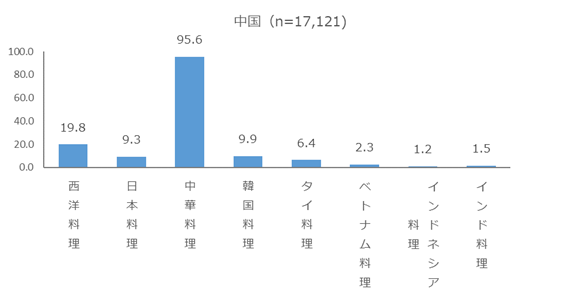[Global Viewer - Data on people living overseas] Eating Out in China
- Release date: May 28, 2025
- 3032 Views

In today's age of globalization, food diversity is accelerating and the choices for dining are expanding. In Japan, eating not only Japanese food but also Chinese, Korean, Italian, French, and other foreign cuisines is an everyday occurrence. But what about overseas? What options do overseas residents consider as candidates when dining out? This article describes the dining out situation of Chinese people and its characteristics.
Eating out habits of Chinese consumers
What kind of food do Chinese people often eat when dining out?

Figure 1: Types of food eaten at restaurants (multiple choice) (Base: Chinese 18-64 year old men and women)
The data on “Types of Cuisines Eating Out on a Regular Basis” (see above) shows that the percentage of respondents who eat Chinese food is overwhelmingly higher than other types of food, with only 10-20% of respondents eating Western or Japanese-Korean food. It may seem natural to give preference to one's own cuisine, but is the trend the same in other Chinese countries?

Figure 2: Type of food eaten when eating out (multiple choice) (Base: Hong Kong, Taiwan, and Singapore 18-64 year old men and women)
People in Hong Kong, Taiwan, and Singapore are most likely to choose Chinese food, the same as in China, when eating out, but they seem to be more deeply penetrated than in China in terms of dietary diversity. In particular, trends in Hong Kong and Taiwan, where the residents are mostly of Chinese descent, show that the percentage of people choosing Japanese and Western food when eating out is between 30% and 50%, much higher than in mainland China. The high level of acceptance of Western and Japanese food can be explained by the history of British and Japanese rule and the relatively early presence of Western and Japanese companies in China.
Is there a category of “Chinese food” in China to begin with?
In Japan, it is a common idea to describe culinary categories at the national level, such as “Chinese cuisine” or "Italian cuisine. In China, on the other hand, “Chinese cuisine” is not often used as a blanket term. Instead, when eating out, people often think in terms of subcategories within "Chinese cuisine. The top choices include hot pot, char-grilled (yaki roast), which involves a wide variety of seasonings, Sichuan and Hunan cuisines, which make heavy use of chili peppers, and Cantonese cuisine, which is less seasoned.
(From top) Charcoal Grill, Hunan Cuisine, Cantonese Cuisine
The vast land area of mainland China has given rise to a variety of climates, and each province has its own unique food culture, making it difficult to use the term “Chinese cuisine” to comprehensively describe all cuisines. The most influential cuisines are referred to as the “菜系” (cuisine type), and it is generally recognized that there are mainly “eight major cuisine types”. In addition to the Sichuan, Cantonese, and Hunan cuisines mentioned earlier, there are also Shandong, Jiangsu, Fujian, Anhui, and Zhejiang cuisines. What kind of cuisine you choose depends quite a bit on the occasion. For example, when you want to have fun with friends and family, hot pot and charcoal-grilled dishes are the standard, while for business meetings and formal occasions, you are more likely to go to famous restaurants such as Cantonese or Sichuanese-style restaurants. In large cities, there is also an elite group of people in their 30s and 40s who order Omakase (a sushi and snack course in which the chef is entrusted with the menu and the freshness and skill of the ingredients) at high-end sushi restaurants as a reward for themselves, or go to Western restaurants for high-end steaks and other Western cuisine.
Thus, Chinese cuisine, which is lumped together as “Chinese food” in Japan, actually has a variety of options within it. This may be one of the reasons why the percentage of people eating exotic cuisine in China tends to be low, as they can choose from and enjoy a sufficiently wide variety of options without having to select Western, Japanese, or other foreign cuisines.
What is Global Viewer?
This service provides reports tailored to your issues using questionnaire data on various actual conditions and attitudes of sei-katsu-sha in 11 countries (Asia and US) stocked by INTAGE.
The service covers 400 items, including actual behavioral conditions and awareness, values, and information contact related to various product and service categories (*).
Examples of categories:
Food and beverages, personal care/cosmetics, house hold care, childcare/nursing care, mobility, home appliances, smart home, housing, entertainment content (games, music, etc.), finance, insurance, travel (to Japan), online services, etc.
In addition to country-by-country comparative analysis as described in this article, analysis by attributes (sex, age, income, etc.) within a single country is also possible.
For details, click here.
-

Author profile
Xuanjin Guo
Researcher from China. She provides information on the living conditions of Chinese consumers in Mainland China, Hong Kong, Taiwan, and other parts of Greater China.
-

Editor profile
Risa Takahama
After working in marketing research support for Japanese FMCG manufacturers (cosmetics, baby products, food and beverages, etc.) in Asia, Europe, and the U.S., from 2019, in his current position, he develops solutions for overseas marketing research for Japanese companies and conducts seminars and other outward communications.
 Global Market Surfer
Global Market Surfer CLP
CLP